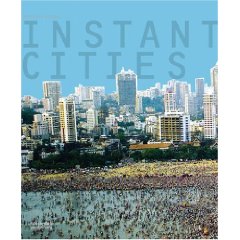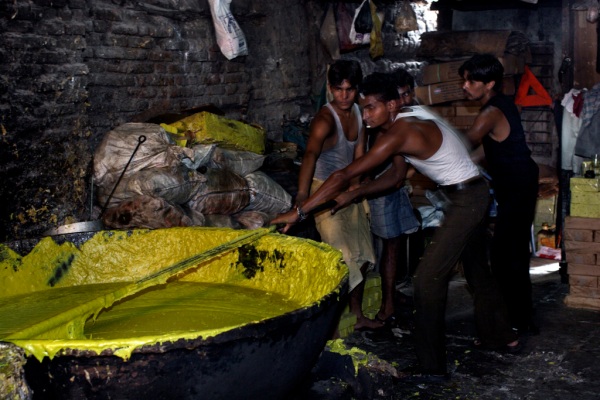(…read in spanish)
Subscribe to Kurioso in english ![]()
.
My name is Krishna Pooraji, and I want you to come with me through the most shocking trip you’ve ever done with your mouse scroll. I live and work at Dharavi, Bombay’s slum, city of pariah and one of the most degraded suburbs on Earth. Almost 400.000 people per kilometer square are waiting for you with a smile into their humble huts while they survive their hopeless fate. They’re poor and ‘untouchable’ but without weapons, no violence and neither crime. Welcome to the city of the happy misery.
Sunset at Dharavi. National Geographic.
Coexistence. Source: Ayan
.
Dharavi is located at the north of Mumbai’s downtown, in India. One of the cities with more contrasts of the planet. Two highways demarcate its territory and isolate it from the rich area of the capital. One million of souls sharing hardly 3 square kilometers of flooded terrains and more than 60.000 huts in less than 10 square meter each one.
Excellent slideshow by Michael Robinson Chavez.. Los Ángeles Times
.
I want you to know our way of surviving day after day. I’m going to take you by some spots of my suburb through shortcuts and narrow streets. You should come walking because the narrowness doesn’t let any vehicle pass, even the famous rickshaws.
Industry’s Avenue. Source
.
Please carry some mineral water. We don’t have distilled water in our houses. Two hours a day the public fountains barely give us back the water that we ever banish. Paradoxically our city is lying crosswise by two of the largest water sewer that serves the capital. Two pipes of 2 meters of diameter each one refreshes us at contact in summer and vaporizes humidity in winter. By the way, don’t drink a lot. We just have one toilet for every 2000 per resident. Not enough for foreigners with scruples. And don’t forget closed footwear too. Both sides of the main ways are crossed by the open fecal channels that are full of the content from our latrines.
Water sewers that cross Dharavi. Source
.
We’ll go to the Kuthoop Hotel at the center of Potter’s Street. The most luxurious of our hostels for foreigners and guests.
Kuthoop Hotel entrance. Dharavi. Source
.
We’ll sleep in these beds that are raised enough to allow all kind of rats pass below it. We’ll rest until the sunrise.
Sleeping at Dharavi. Source
.
Don’t get under stress by the people staring you. All foreigners cause surprise and impression at Dharavi, but always in a good way. Most of my neighbors have never left Dharavi. That’s why we have to make it all in our own. We have markets, undercover schools, hostels, religious temples and even hospitals.
Going for a walk at Dharavi.
.
Two train tracks without stops are place across the city. Every three minutes we have to leave the train sleeper for clearing the most important street in Dharavi. Important business and shops are piled up surrounding these tracks. Is our showcase and connection with the outer world. The only way to show our crafts to the foreigners.
Dharavi. Source
.
Do not carry any money. You won’t need it. We trade here with small and colorful pieces of plastic that we use as coins and barter. We recycle them from the dirt for reselling it to the toy industry of the capital city. That is why is very common the exchange of staples for this particular coin.
Recycled color plastics. The internal coin at Dharavi. Source
.
The land and the circumstances are our main resources as you can see. With the clay of the ground we practice the pottery. And with the soaps collected from the hotels and residences we melt them and remake with it our bright and aromatic version that we resell in the market. Over 20.000 shops can be found through our narrow streets.
Stirring molten soap. Source
.
.At the end of our main road is placed our post office. You could send this ‘postcard’ to anywhere.
Post office. Dharavi Main Road. Source
¡Greetings from Dharavi and thanks for joining me brother!
.
.
Sources and links:
 My encounter with Dharavi was reading a statement from Prínce Charles about the sustainability in the neighborhood of Dharavi. The most incredible of the narration (fictionalized) is that the character Krishna Pooraji (our touristic guide) is real and works for an enterprise (Reality Tours) that offers travels through ‘the other side’ of the biggest slums on earth, Dharavi included. Other links that helped me can be found here, here and here. Obviously the references to Dominique Lapierre and his “The City of joy” are inevitable. Highly recommended the book «Instant Cities» de Herbert Wright. and the recent movie filmed in Dharavi and in the suburb of Juhu, Slumdog Millionaire.
My encounter with Dharavi was reading a statement from Prínce Charles about the sustainability in the neighborhood of Dharavi. The most incredible of the narration (fictionalized) is that the character Krishna Pooraji (our touristic guide) is real and works for an enterprise (Reality Tours) that offers travels through ‘the other side’ of the biggest slums on earth, Dharavi included. Other links that helped me can be found here, here and here. Obviously the references to Dominique Lapierre and his “The City of joy” are inevitable. Highly recommended the book «Instant Cities» de Herbert Wright. and the recent movie filmed in Dharavi and in the suburb of Juhu, Slumdog Millionaire.
.
.
.
 Share this post
Share this post
 Thanks to @eddiedean for translating this post
Thanks to @eddiedean for translating this post




































1 comentario